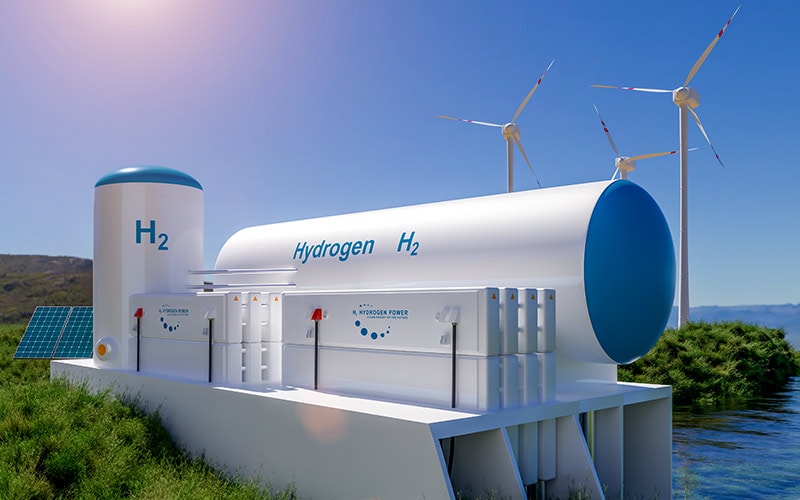Introduction
It’s imperative for utilities to modernize their electric grids and address the bidirectional power-flow challenges created by distributed energy resources. Regulatory emphasis and improved price competitiveness for renewable resources are placing increased stress on a power grid that was never designed to handle bidirectional power flows. The current electric grid wasn’t designed to manage the complexity of DERs. Besides helping address the challenges posed by DERs, grid modernization has a number of additional benefits, including improved reliability, public safety, operational efficiency, resiliency and accelerated restoration, which are highlighted in a previous paper titled “The Case for Grid Modernization.”1
Utilities with significant DER penetration will more acutely feel the pressure to modernize. Wind is not a DER.
DER penetration is accelerated by both aggressive de-carbonization regulatory regimes and the improved economics of solar vis-a-vis coal, natural gas, and nuclear.
As solar affordability increases, so does the pressure to modernize the grid
The purpose of this paper is to assist those utilities interested in embarking on the grid modernization journey in understanding the capabilities required as well as the most appropriate ways to sequence their implementation. The goal of the grid modernization journey is to digitize grid operations in order to improve situational awareness, efficiency, reliability, resiliency, public safety, and to accelerate restoration.
Digitized grid operations improve situational awareness, efficiency, reliability, resiliency and public safety.
The grid modernization journey
As utilities embark on the grid modernization journey, they will need to enhanced their processes with increased automation and predictive grid management capabilities in order to keep up with the changing nature of demands on the electric grid. Figure 1 sets out a framework in which these capabilities can be understood. There are four layers to the grid modernization framework: 1) physical 2) data foundation 3) engineering and planning 4) monitor and control. Significant upgrades are needed for all four layers to reach the end goal of safely and reliably managing a more unpredictable and complex grid. In this paper, we’ll discuss each layer and the enhancements brought about by utility grid modernization.
Physical layer
SCADA and AMI devices
Supervisory control and data acquisition sensors provide real-time data that give utilities an up-to-the-minute understanding of the state of the grid. SCADA can help pinpoint problems on the grid and enable relays to turn off power lines that could destabilize the grid. SCADA can help prevent widespread outages. Real-time SCADA information from the field allows utilities to locate the tiny section of a circuit where there’s a problem. Remote switch operations can isolate the problem and restore power.
While almost all utilities already have some type of SCADA, advanced meter infrastructure or smart meters are less common. Just 47% of the 150 million U.S. electricity customers had smart meters as of December 2017.2 AMI is one of the first steps required in order to digitize the electric grid. When the power goes out, AMI meters immediately alert the utility.
Figure 1. Grid modernization capabilities pyramid: There are four layers of significant upgrade and four maturity levels on the journey to a modern grid.

Source: Infosys Consulting
Remote control devices and DERs
Digitizing physical assets by enabling them with remote monitoring and control features is the foundation utilities need to begin the grid modernization journey.
There are two key elements to the digital transformation of the physical network:
- Digital representation of assets — It is critical to create an accurate digital representation for every physical device, and that includes key device attributes as well as geospatial position. A digital model of the electric grid needs to include AMI, DERs, circuits, structures and distribution SCADA devices such as voltage regulators, switches, capacitors, etc.
- Real-time “internet of things” data — Internet of things data can be collected by sensors on a variety of assets, including load generation information, VAR (voltage-ampere reactive) and generation information at different points in the network, all the way from the meter to the AA bank substation.
Communications network
Advanced field devices such as automated capacitors, remote fault indicators, automated voltage regulators, smart relays, feeder and transformer monitors, and automated feeder switches are imperative to implement distribution automation on a modern grid. To make distribution automation work, field devices are typically equipped with wireless, cellular or radio communication to send data to collection points. The data are integrated into the SCADA system, distribution management system and outage management system for processing and analysis.
According to the U.S. Department of Energy, DA operations eliminated sending out more than 197,000 utility trucks and the need for 3.4 million vehicle miles to be traveled from 2011 to 2015.3 The addition of so many connected devices to the grid infrastructure increases the load on the supporting communication networks. Robust communication networks are critical for monitoring network equipment, feeding real-time state information, and processing control signals to change device state and configurations. Existing wide area networks and field area networks will likely require upgrades, including additional field area radio devices, routing optimization, latency reduction, reliability, and redundancy enhancements in order to support increased network traffic.
Most utilities want to fully realize grid modernization capabilities but are far from being able to do that. Upgrading the physical layer is not only time-consuming but expensive. That’s why it’s so important to develop a long-term road map and set time lines for building advanced capabilities in system planning and operations.
Data foundation
Scalability
With millions of SCADA and AMI devices sending back data every few seconds, the data processing, storage, transformation, analysis and predictive capabilities required by utilities demand massively scalable data lakes. In addition to internet of things data, utilities will require a variety of additional data sources (weather station information, projects pipeline, third-party DER generation information, econometric information by geography, etc.) to make long-term decisions such as predictive load modeling or real-time decisions such as fault isolation and restoration.
Data modeling
As utilities try to rationalize data models for managing digital information across various domains, they will likely be haunted by decisions made decades ago. The processing power available today makes use cases possible that couldn’t even be envisioned just a few short years ago. New systems and processes that rely on information created and maintained in legacy data structures run the risk of uncovering data quality issues that are hidden within existing production systems. Until someone started using data in a new and novel way, these data quality issues were never critical, so they just didn’t get fixed. In order to minimize these risks, it is imperative that grid modernization initiatives place extra emphasis on both data modeling and data quality.
Data governance
A robust data governance and data quality management program is critical to the ultimate success of any grid modernization program. The core engineering and planning capabilities need to be built on a quality data foundation.
Geographical information systems
GIS allows utilities to visualize electric assets such as transformers and capacitors on a map. When a power pole goes down, GIS knows exactly where it is on the grid and which customers are affected.
Connectivity model
Capturing the connectivity model from substations to customer meters is another foundational data category. Meters and circuit configurations are constantly changing in the field, and it’s difficult to maintain a real-time image of the network model when things are changing very rapidly. It’s challenging to absorb all these changes, keep the network model up to date, and provide real-time changes for power flow studies and operations. As a grid connectivity model evolves through its life cycle, it will undergo several substantive changes, so utilities need to recognize that the “as planned” model will be different from the “as designed” and the “as built” and the “as operated” grid connectivity models. Recognizing these changes and being able to accurately keep track of the current state of the grid is critical not only to effective grid operations but also to long-term engineering and planning.
A significant investment may be required to build the data foundation before realizing the benefits of smart algorithms and tools used for system planning and operations.
Engineering and planning
System modeling
System modeling is part of the smart modern grid that will help utilities plan how much power they’ll need to generate in the future. If the utility has a base model, network model and equipment ratings, it will know exactly how much current is flowing from one point to another. System modeling can create a live network model. When a utility uses historical data to create that model, it can predict how many additional houses, factories, etc., the current grid can power without any upgrades. This kind of analysis will allow utilities to see a capacity-draining spike years ahead of time, prepare for it and avoid a major outage.
Forecasting
Historically utilities have employed annual peak load forecasting to identify required upgrades to the grid. With the proliferation of DERs and the two-way flow of power, the need for more sophisticated forecasting algorithms will become more acute. Time series forecasts that provide load profiles for each node on the grid will be required to effectively plan for future load on a much more complicated grid. Creating a long-range time series forecast that accurately predicts the expected gross and net load at every node for every hour of the day is a monumental challenge. Historical load data needs to be combined with weather station information, projects’ pipelines, third-party DER-generation information and econometric information to create historical load profiles for every node on the network. The profiles need to be cleansed and smoothed to eliminate anomalies. Forecasting models then need to be applied to cleansed historical usage data and compared to historical load profiles in order to fine-tune the forecasting models.
More DERs create a critical need for more sophisticated forecasting algorithms
Interconnection automation
With states and territories such as California, Washington, Hawaii, New Mexico, New York, Nevada, Maine, Washington, D.C., and Puerto Rico passing 100% renewable mandates, the volume of grid interconnection requests is expected to explode. In fact, California has mandated that all new homes in the state need to include solar panels. To cope with the increased demand, utilities need to think about interconnection automation as a way to improve the efficiency of what can be a very cumbersome and time-consuming process.
Engineering analysis
One of the key annual goals of utilities is to do the system planning for their distribution and transmission grids and share results with the regulatory agencies. In a grid of the future, the planning needs to be granular enough to factor in the variations at the different points on the grid and at different times of the year. Various factors that affect the load and generation profiles at any point in the grid are customer load requirements, generation profiles, weather factors, econometric factors, load growth predictions, demand response and energy-efficiency programs, and other temporary changes to the network.
To do a thorough job on predicting capacity, utilities need very accurate time-series load/DER profiles along with the various factors listed above. Wherever capacity requirements cross predefined thresholds, utilities need to provide capital or noncapital solutions to address capacity shortfalls. Capital solutions will include upgrades at various points in the grid to meet the energy requirements. Noncapital solutions will be made up of load transfers to adjacent circuits with available capacity as well as other circuit configuration changes that can be done using current capacity within the grid. In addition to capacity analysis, engineers perform protection analysis, thermal analysis of duct banks, contingency analysis, volt-var analysis and many other power studies to ensure the grid is capable of handling the growing energy and generation demands.

Monitoring and controlling grid operations
A modernized grid makes restoring power much faster and easier for the utility and its customers. In the past, a customer might call to report a power outage, and the power company would send a line repairer out to see what was wrong. On a modernized grid, the AMI meter will immediately alert the utility company of the outage, and real-time SCADA information will locate the small section of the circuit where there could be a problem. SCADA points send back real-time data every 15 seconds. Remote switch operations can be used to help isolate the problem and restore power before even sending a person to look at the issue.
Modern grid management will allow a utility company to see in real time the exact generation coming in from each DER and whether there’s an imbalance in voltage or load. The utility will then be able to remotely balance the load and any discrepancies without having to physically go out and fix them. With real-time data feeds coming in from each line, utilities will have a lot more information than they do today.
Fault location, isolation and service restoration
FLISR systems use SCADA-enabled switches and sensors to create a powerful “self-healing” grid capability. FLISR can restore power to the functional sections of a faulted line in seconds. A Department of Energy study found that FLISR operations reduced the number of customers interrupted by 55% and reduced the customer minutes of interruption by 53%.4 SCADA, AMI and FLISR can work well together to optimize grid operations.
Outage management
In addition to finding outages and helping heal the grid, SCADA provides visibility to the rest of the grid. For example, the outage management system and distribution management system are often used to integrate different sources of fault information such as AMI, line sensors, customer calls and reclosers. The data is displayed on SCADA screens and GIS for both field crews and control room operators.
Advanced distribution management
The rapid adoption of DERs across the distribution network is going to pose additional risks to managing the grid in real time. Utilities need to monitor and control the generation capacities at different points in the grid based on contractual agreements developed during DER installation. Advanced distribution grid management would require advanced monitoring of devices at different points in the distribution grid, cost optimization by addressing energy needs through DER solutions, achieving operational efficiency through integrated switching operations, having higher control over SAIDI/SAIFI (or system average interruption duration index/system average interruption frequency index) goals through integration of outage management and remote operations of devices, and possibly enabling automated fault detection, isolation and restoration of interruptions.
Cybersecurity
The future grid will be more distributed and interconnected, and it will function very differently from what we have today. Security will be one of the fundamental tenets on which it’s designed. The massive deployment of renewable energy and grid edge devices, such as electric vehicles, smart home devices, home management systems, new batteries and distribution systems, makes for a more responsive grid that’s more efficient and cleaner. But it also means an increase in connected devices, which all provide opportunities for cyber adversaries to cause damage. To protect itself, the modern grid must be designed with cybersecurity platforms and services that support multiple applications and technologies to ensure interoperability. The ambition should be to create a protective cybersecurity architecture that protects against advanced persistent threats and exceeds regulatory compliance.
On the modern grid, cybersecurity must support multiple applications and technologies
Where to start
A comprehensive grid modernization initiative would likely require rate increases that are unsustainable for customers without substantial government subsidies. Therefore, it is imperative for utilities to prioritize their grid modernization investments and develop a long-term plan for continuously improving the maturity of their grid in order to cope with changing load profiles.
While the basic physical foundation needs to be put in place first, it isn’t necessary for all layers of the grid modernization pyramid to be at the same level of maturity at the same time. A number of monitoring and control capabilities are delivered directly from the physical layer, but a mature physical layer and data foundation are required prior to effective delivery of advanced engineering and planning capabilities. Organizations should start by:
Defining the capabilities required for a modern grid.
Understanding the dependencies and risks associated with each capability.
Prioritizing the delivery of grid modernization capabilities based on business impact, budget constraints and dependencies.
As momentum for decarbonization of the electric grid continues to build, utilities will be forced to cope with increasingly volatile load profiles by embracing grid modernization capabilities and technologies.
References
- “The Case for Grid Modernization,” Infosys Knowledge Institute, August 2019
- “Nearly half of all U.S. electricity customers have smart meters,” U.S. Energy Information Administration, December 2017
- “Distribution Automation: Results from the smart grid investment grant program,” The U.S. Department of Energy, September 2016
- “Distribution Automation: Results from the smart grid investment grant program,” The U.S. Department of Energy, September 2016





